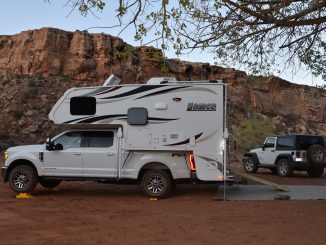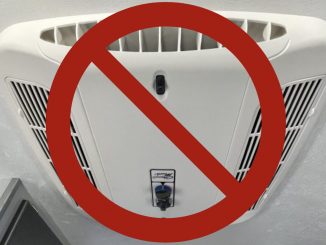
Truck camping and e-bikes make an excellent combination for us. Our passions include landscape photography, long hikes, and good meals cooked over a campfire. Often, our campsite is not the best location for shooting a sunset photograph or starting the long hike we planned. We prefer to avoid stowing the breakfast dishes and popping down our Phoenix Pop-Up after breakfast. So, e-bikes are a natural and delightful way to get around any camping location. While Jenney makes dinner, I often ride to capture the golden hour’s light at a photogenic site. And sometimes, it is a lot more fun and easier to e-bike than hiking where allowed. For example, at Valles Caldera National Monument, we explored twenty miles of trails deep in the Monument’s ponderosa forests and beautiful Valles. It’s easy to go a few or even up to 30 miles on an e-bike and have a blast doing it.

We considered regular bikes, e-bikes, and scooters. Regular bikes just aren’t as much fun after returning from a long, hard hike and then having to get on a bike to get 5-10 miles back to our campground. Scooters can’t go on nearly as many trails. This is why we settled on e-bikes. We haven’t regretted the decision.
One of our favorite planned locations for e-biking was Chaco Canyon National Historic Park’s ten-mile loop road. We could take our time on the loop road and visit all the pueblos with less hassle than driving the truck camper. The park also has three trails that allow mountain and e-bikes. We saw several more distant Pueblo sites by e-biking to the end of old abandoned roads and then hiking on the trail to shorten these longer hikes. Another great ride was at Colorado’s Ridgway State Park. The beautiful snow-capped peaks of the San Juans surround the bike path from the park to the quaint town of Ridgway. Last fall, I volunteered at Shenandoah National Park as a “Fall Foliage Photographer.” I used my e-bike to ride from the campground to the numerous trailheads and overlooks to capture the colors without packing up and driving. It didn’t just save time and have more fun, but it also helped avoid parking at crowded parking lots.

Some of the places we e-biked were pleasant surprises that we stumbled onto. They were great rides. We went alligator “hunting” along the Shark Valley Tram Loop Road (no cars allowed) in Everglades National Park. We saw scores of alligators up close and personal in our 20-mile ride. We discovered Colorado’s Mueller State Park had miles of old ranching roads open to e-bikes with stunning views of Pikes Peak along the Cheesman Ranch Trail and the distant Sangre de Christo Range to the south. Padre Island National Seashore offered unlimited riding and boondocking along the miles of sparsely populated beach. City riding is a good way to get around some cities. We ride in Washington DC all the time. We thought about riding in New Orleans on one trip but chickened out since it was a long ride from our campground to the city, which involved a ferry ride across the Mississippi. Once we got downtown, we discovered a great secret. At the visitor center, you can boondock for $10/night which would have made exploring the French Quarter on e-bikes easy.

E-bikes provide a different ride compared to regular bikes of comparable size. They are heavier and less agile, making starting from a dead stop harder. Since most e-bikes have a throttle, give it a quick twist to get started. It is much easier than only pedaling to get rolling. This is one of the few times we use our throttles since throttle-riding will significantly shorten your ride. They are also harder to stop, so we recommend an e-bike with hydraulic disk brakes.

We went through three iterations on how to carry e-bikes on our truck camper. Our first attempt was to use our front hitch with a heavy-duty hitch-mounted bike rack. E-bikes require a heavy-duty rack since e-bikes almost always weigh more than 50 pounds. Most heavy-duty racks can only hold two 60-pound bikes. But the front mounting obscured our vision. So next, we bought a “swing-out arm” and put the swing-out arm on the rear hitch and the bike rack onto it. This way, we could swing the bikes out of the way of the rear camper door. This worked, but we were close to the max weight limit for the swing-out-arm. Also, there were way too many different keys to keep everything locked, and it partially blocked our backup camera, which resulted in several “backup bumping” incidents.
Additionally, most e-bike rack manufacturers do not recommend carrying e-bikes on the bike rack on rough dirt roads. There is too much stress on the rack. This is a significant limitation since we are increasingly overlanding on our trips. We decided to sell our e-bikes and buy folding e-bikes so we could load them in the back seat. This works great and is our solution. We have been on numerous rough roads with no incidents. We can fold the bikes, put them into a bike bag, and load them into the back seat quicker than we can get them on or off the racks and lock or unlock the e-bikes.
Per federal law, there are three classes of e-bikes. Class 1 bikes only provide pedal assist up to 20 mph and do not have a throttle. You must pedal to get the bike going, and the motor helps you to reach a maximum speed of up to 20 mph. You can pedal faster than 20 mph if you want, but you won’t get any assistance from the motor. Class 2 bikes have a throttle and provide pedal assistance up to 20 mph. You can ride only using the throttle but will get less range. You can also use only pedal assist or a combination of both. Class 1 and 2 e-bikes generally have 500 watt (2/3 Horsepower) motors with 50 Newton-meters of torque, slowing you down a lot on hills. Class 3 bikes provide pedal assistance up to 28mph but no throttle. Class 3 e-bikes often have 750 watt (1 Horsepower) motors with 80 Newton-meters of torque, which will keep you zipping up all but the steepest hills. There needs to be more clarity with the classifications since most e-bikes come with a throttle, therefore not fitting into the federal classifications. In my opinion, the max speed from the motor is the key attribute of the classification since speed has the most impact on safety on mixed-use trails.

The significance of these classifications directly impacts where you can ride. Class 1 and class 2 e-bikes are generally allowed on most bike lanes, paths, and mixed-use trails unless prohibited by the trail manager. Class 3 e-bikes are typically allowed on bike lanes but are often more restrictive on mixed-use trails due to their higher speeds. Many local, state and national land managers have unique regulations, so pay attention to where it is legal to ride. Also, be safe and courteous to help prevent a trail from being closed to e-bikes by rude and unsafe riding.
Since we are short, 20-inch fat tire bikes fit better, yet give us access to rougher trails and forest service roads. There are skinny and fat tires in different diameters and frames of different sizes. Bigger diameter and fatter tires generally give a better ride on rough roads but are heavier and less agile. Smaller tires make e-bikes lighter and more agile, but they may be harder to ride on rough trails. Step-through frames and folding bikes are weaker for rough riding than bikes with a top tube. None are straightforward to pack in a truck camper. So think hard about how and where you want to ride and how you want to pack them in your rig to avoid the learning curve we went through. Then, start your search for an e-bike.
Nowadays, there are numerous suppliers of good e-bikes for recreational riding. Most are made in China. But you can still get good deals if you stick with an American distributor, so there is an actual warranty and better-quality control, especially with the batteries and battery charger. Competition has driven prices down as many new companies enter the recreational mid-price e-bike market. Now is an excellent time to join the fun.
Our first two e-bikes were the Mountain-to-Sea Scout and the Rad Radrunner Plus. The Mountain to Sea was great, and we feel it was a much better bike for the money than the Radrunner Plus. Now, we have two folding Lectric XP-3 Step-Through e-bikes with an extended-range battery. And they easily fold up and fit in the back seat of our truck. They have great range and decent components but aren’t as “tough” and sporty as my old Mountain-to-Sea Scout. Regarding the price and the quality of the bike, Lectrics is probably one of the best values in the mid-price e-bike market.


















Mike: what size truck do you have? Crew or super cab. Great article about your bikes as we are in the transition. A photo of bikes in the back seat would be great.
I have a ford F350 XLT with the extended cab (1/2 not full rear door). I’m not sure why, but I don’t have a photo of the bikes in the back seat. I will be able to get one in early January when we pick up our new Phoenix Camper in Denver and put them in the back seat again. The seats have to be folded up.
Since weight is a much more critical factor in truck camper setups, you should checkout JackRabbit electric bikes. https://jackrabbit.bike/ They only weigh 25lbs compared to most electrics that weigh 60-75lbs.